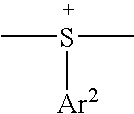Silicone composition used in the production of antifriction varnishes, method for the application of said varnishes to a support and support thus treated
a technology of silicone composition and anti-friction varnish, which is applied in the field of polymer coatings or varnishes, can solve the problems of reducing the friction coefficient, damaging the application of numerous applications, and the sticky feel of the coating layer made of elastomeric silicone, etc., and achieves easy and industrial crosslinking, confer significant anti-friction characteristics, and easy application and crosslinking
- Summary
- Abstract
- Description
- Claims
- Application Information
AI Technical Summary
Benefits of technology
Problems solved by technology
Method used
Image
Examples
examples
In the examples which follow, the production of formulations which can be directly exploited for the production of UV varnish for air bags is described.
examples 1 to 14
Photocrosslinkable varnish formulations are prepared from the following polymers:
A /
A1 / SILCOLEASE® UV POLY201: x=CH3; a=70; b=7
A2 / SILCOLEASE® UV POLY201; x=CH3; a=444; b=35
C2 /
Photoinitiator SILCOLEASE® UV CATA 211
Photoinitiator RHODORSIL® Photoinitiator 2074
G2 / Aerosil silica having a specific surface area of 300 m2 / g from DEGUSSA treated with octamethylcyclotetrasiloxane Red 22 / red pigment marketed by SUN CHEMICAL.
These compositions are then applied with the aid of coating bars numbered differently from 0 to 6 in order to deposit from 1 to 20 g / m2 on a rectangle of polyamide fabric comprising a silicone elastomer at the surface of the crosslinked polyaddition RTV type (140 g / m2).
40 kg of an α,ω-divinylated silicone oil having a viscosity of 1.5 Pa.s with a titer of 0.1 meq of vinyl (Vi) per gram of oil, 0.24 kg of potable water and 0.24 kg of hexamethyldisilazane are introduced into a 100 l arm mixer. After homogenization, 13.9 kg of a pyrogenic silica characte...
example 15
Trials for the continuous application of the formula described in example 13 are carried out on a machine representative of an industrial equipment (pilot ROTOMEC) at 25 m / min on a width of fabric coated with RTV of 30 cm.
The irradiation conditions are obtained with a lamp from the company Fusion with an “H+” type bulb having a power of 80 W / cm. 3 deposits are made.
The coefficients of friction are then measured on glass.
The following are obtained: 3.5 g / m2 of varnish corresponds to a Ks=1.4 6.0 g / m2 of varnish corresponds to a Ks=0.8 9.0 g / m2 of varnish corresponds to a Ks=0.5
The expected performances are indeed found for this formulation at a comparable deposit.
PUM
| Property | Measurement | Unit |
|---|---|---|
| thickness | aaaaa | aaaaa |
| thickness | aaaaa | aaaaa |
| temperature | aaaaa | aaaaa |
Abstract
Description
Claims
Application Information
 Login to View More
Login to View More - R&D
- Intellectual Property
- Life Sciences
- Materials
- Tech Scout
- Unparalleled Data Quality
- Higher Quality Content
- 60% Fewer Hallucinations
Browse by: Latest US Patents, China's latest patents, Technical Efficacy Thesaurus, Application Domain, Technology Topic, Popular Technical Reports.
© 2025 PatSnap. All rights reserved.Legal|Privacy policy|Modern Slavery Act Transparency Statement|Sitemap|About US| Contact US: help@patsnap.com



